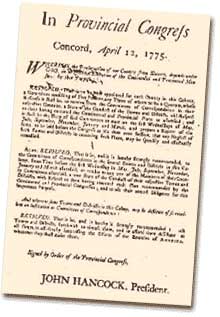10c. Committees of Correspondence

Copy of Broadside from Boston, Massachusetts, 1775
Volumes and volumes of written work was emerging in the American colonies on the subject of British policies. Apart from major documents and publications, much writing had been produced as letters, pamphlets, and newspaper editorials. The arguments set forth in this way were at times very convincing. American patriots of the 1770s did not have modern means of communication at their disposal. To spread the power of the written word from town to town and colony to colony, Committees of Correspondence were established.
The first such committee was organized by none other than Samuel Adams. Working with rural patriots, Adams enabled the entire Massachusetts citizenry to have access to patriot text. In fact, Adams knew that the residents of the seacoast towns were more informed of each crisis than those of the interior. The spread of these committees across urban centers happened quickly. Adams and others urged the establishment of correspondence committees in rural inland towns as well.
The Committees of Correspondence were bold enough to use the British postal service as the means of communication. For the most part, the pen was their weapon of choice, but revolutionary sentiment did at times take other forms. For example the Committee of Correspondence in Boston gave its blessing on the raiding of the Dartmouth and the destruction of its cargo that became known as the Boston Tea Party. As the revolution drew nearer, the committees became the spine of colonial interaction. The Virginia House of Burgesses followed Adams' lead and established a Committee of Correspondence as a standing committee in 1773. Before the Tea crisis had passed, each colony had a central committee designed to coordinate discussion with the other twelve colonies. In effect, these Committees of Correspondence were the forebears to the First and Second Continental Congresses.
Successful national organization must begin locally. Congresses and national coordinated actions do not materialize out of thin air. Without the work of thousands of local patriots — north and south, urban and rural — there can be no unified result. The Committees of Correspondence became the building blocks on which national unity could begin to build its foundation.





